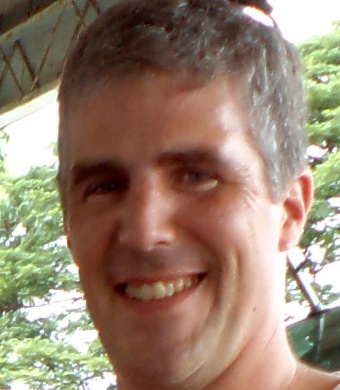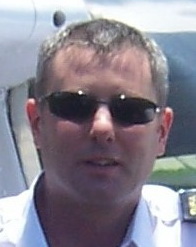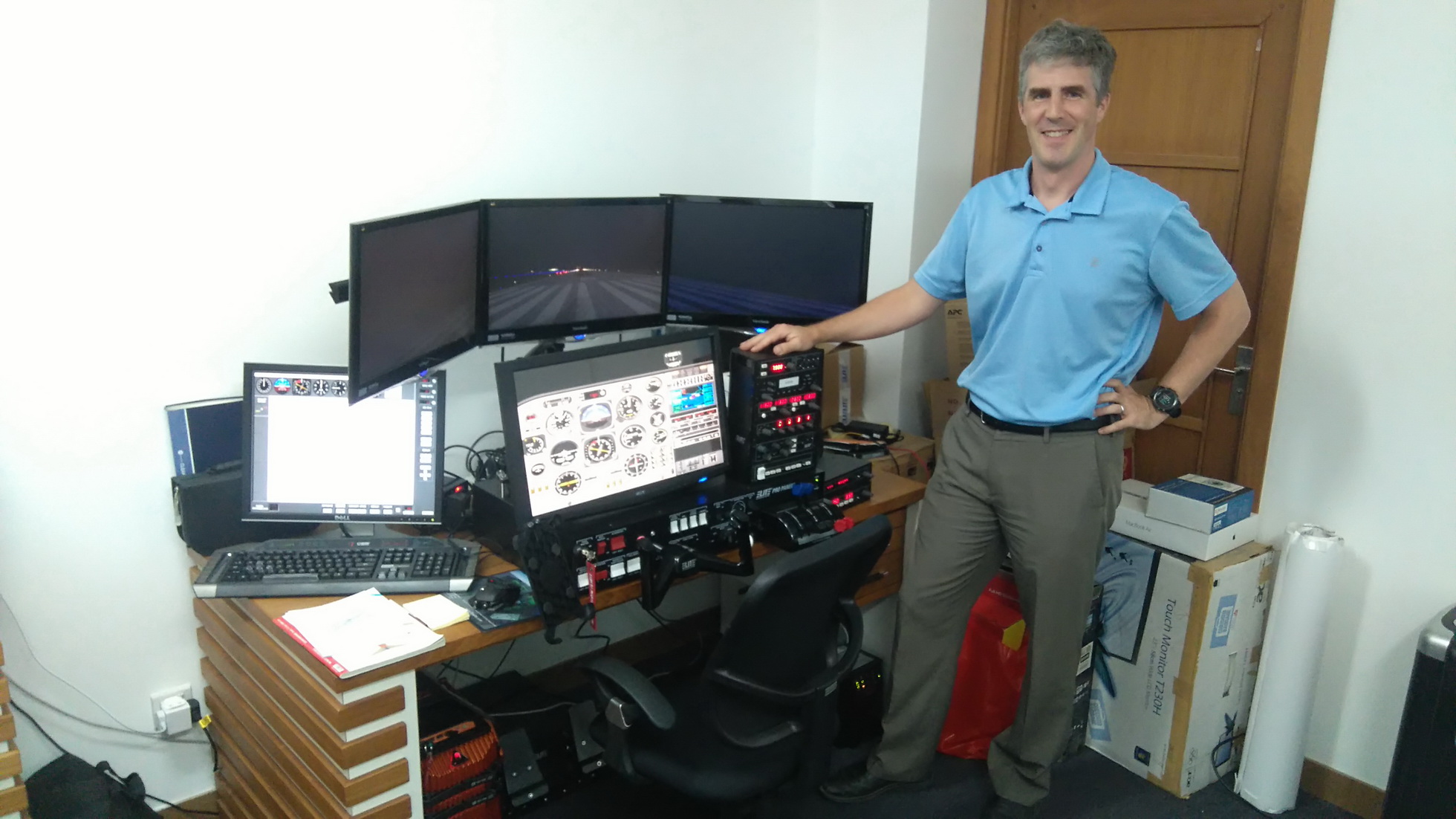|
 |
Michel Ryf
lives in Bangkok. He is an FAA & JAA ATPL corporate jet pilot with
experience flying all over the world. He is from Switzerland and is a member of Thai Flying Club.
He can BFR and IPC.
Mobile: +66922536990
Email: mrbleriot939@gmail.com
updated: Dec 2014 |
|
 |
Alexander Slingeland
lives in Yangon, Myanmar. He is a member of Thai Flying Club and is
interested in bringing more Kitfox aircraft to Southeast Asia. He is an FAA
CFII. He can do BFR checks at TFC and Instrument Currency checks. He also
has an Elite PC135 for maintaining currency by doing 6 approaches and
holding every 6 months.
Moblie: 208.337.5111 (usa)
Email: alex@kitfoxaircraft.com
updated: Mar 2016 |
|
 |
Josh Clements
lives in Bangkok. He is a member of Thai Flying Club and he can BFR and IPC. He is an FAA CFII. He can do BFR checks at TFC and Instrument
Proficiency Checks.
Moblie: 0873909631
Email: jscimnts@aol.com
updated: Nov 2012 |
|
 |
Richard Paul
is a member of Thai Flying Club. He flies 747s and J-3 cubs. He lives in
Thailand and Hong Kong. He is able to do FAA BFR checks when he has the
time.
Moblie: n/a
Email: shelbyglhs63@mac.com
updated: Mar 2011 |
|
 |
John Mellor is available to give
BFR checks when he visits Bang Phra or when he is up north. He was based
in the Northwest corner of Bali, Indonesia. Now, he is based in South Korea
(2012).
Mobile: 0849233346.
Email: mellorsemail@yahoo.com
updated: May 2009 |
|
 |
Kongkiat Tantirujananont has 600 hours. He is a Thai
currently working as a CFII Flight Instructor at Pacific Union Aviation
College in California, USA. He comes
back to Thailand once a year for about one month. He will have his Thai
Commercial and IP license shortly and he will be available to give FAA BFR
and Instrument Currency checkrides. Address: 131/39 Sukhumvit 7/1, Bangkok 10110.
Tel: 02-2537739 (h)
Email: kingkongboyz@hotmail.com
|
| |
FAR REGULATIONS (below) courtesy of Ivan Simonov - FAA
instructor sometimes in Thailand - 070192003 - ivaneagle13@hotmail.com |

Alex Slingerland with his
certified Elite Simulator -- Alex is based in Yangon, Myanmar --
alex@kitfoxaircraft.com
FAR regulations.
Sec. 61.56
Flight review.
(a) Except as provided in paragraphs (b) and (f) of this section, a flight
review consists of a minimum of 1 hour of flight training and 1 hour of ground
training. The review must include:
(1) A review of the current general operating and flight rules of part 91 of
this chapter; and
(2) A review of those maneuvers and procedures that, at the discretion of the
person giving the review, are necessary for the pilot to demonstrate the safe
exercise of the privileges of the pilot certificate.
(b) Glider pilots may substitute a minimum of three instructional flights in a
glider, each of which includes a flight to traffic pattern altitude, in lieu of
the 1 hour of flight training required in paragraph (a) of this section.
(c) Except as provided in paragraphs (d), (e), and (g) of this section, no
person may act as pilot in command of an aircraft unless, since the beginning of
the 24th calendar month before the month in which that pilot acts as pilot in
command, that person has--
(1) Accomplished a flight review given in an aircraft for which that pilot is
rated by an authorized instructor; and
(2) A logbook endorsed from an authorized instructor who gave the review
certifying that the person has satisfactorily completed the review.
(d) A person who has, within the period specified in paragraph (c) of this
section, passed a pilot proficiency check conducted by an examiner, an approved
pilot check airman, or a U.S. Armed Force, for a pilot certificate, rating, or
operating privilege need not accomplish the flight review required by this
section.
(e) A person who has, within the period specified in paragraph (c) of this
section, satisfactorily accomplished one or more phases of an FAA-sponsored
pilot proficiency award program need not accomplish the flight review required
by this section.
(f) A person who holds a current flight instructor certificate who has, within
the period specified in paragraph (c) of this section, satisfactorily completed
a renewal of a flight instructor certificate under the provisions in Sec. 61.197
need not accomplish the 1 hour of ground training specified in paragraph (a) of
this section.
(g) A student pilot need not accomplish the flight review required by this
section provided the student pilot is undergoing training for a certificate and
has a current solo flight endorsement as required under Sec. 61.87 of this part.
(h) The requirements of this section may be accomplished in combination with the
requirements of Sec. 61.57 and other applicable recent experience requirements
at the discretion of the authorized instructor conducting the flight review.
(i) A flight simulator or flight training device may be used to meet the flight
review requirements of this section subject to the following conditions:
(1) The flight simulator or flight training device must be used in accordance
with an approved course conducted by a training center certificated under part
142 of this chapter.
(2) Unless the flight review is undertaken in a flight simulator that is
approved for landings, the applicant must meet the takeoff and landing
requirements of Sec. 61.57(a) or Sec. 61.57(b) of this part.
(3) The flight simulator or flight training device used must represent an
aircraft or set of aircraft for which the pilot is rated.
[Amdt. 61-102, 62 FR 16298, Apr. 4, 1997; Amdt. 61-103, 62 FR 40898, July 30,
1997, as amended by Amdt. 61-104, 63 FR 20287, Apr. 23, 1998]
Sec. 61.57
Recent flight experience: Pilot in command.
(a) General experience. (1) Except as provided in paragraph (e) of this section,
no person may act as a pilot in command of an aircraft carrying passengers or of
an aircraft certificated for more than one pilot flight crewmember unless that
person has made at least three takeoffs and three landings within the preceding
90 days, and--
(i) The person acted as the sole manipulator of the flight controls; and
(ii) The required takeoffs and landings were performed in an aircraft of the
same category, class, and type (if a type rating is required), and, if the
aircraft to be flown is an airplane with a tailwheel, the takeoffs and landings
must have been made to a full stop in an airplane with a tailwheel.
(2) For the purpose of meeting the requirements of paragraph (a)(1) of this
section, a person may act as a pilot in command of an aircraft under day VFR or
day IFR, provided no persons or property are carried on board the aircraft,
other than those necessary for the conduct of the flight.
(3) The takeoffs and landings required by paragraph (a)(1) of this section may
be accomplished in a flight simulator or flight training device that is--
(i) Approved by the Administrator for landings; and
(ii) Used in accordance with an approved course conducted by a training center
certificated under part 142 of this chapter.
(b) Night takeoff and landing experience. (1) Except as provided in paragraph
(e) of this section, no person may act as pilot in command of an aircraft
carrying passengers during the period beginning 1 hour after sunset and ending 1
hour before sunrise, unless within the preceding 90 days that person has made at
least three takeoffs and three landings to a full stop during the period
beginning 1 hour after sunset and ending 1 hour before sunrise, and-
(i) That person acted as sole manipulator of the flight controls; and
(ii) The required takeoffs and landings were performed in an aircraft of the
same category, class, and type (if a type rating is required).
(2) The takeoffs and landings required by paragraph (b)(1) of this section may
be accomplished in a flight simulator that is--
(i) Approved by the Administrator for takeoffs and landings, if the visual
system is adjusted to represent the period described in paragraph (b)(1) of this
section; and
(ii) Used in accordance with an approved course conducted by a training center
certificated under part 142 of this chapter.
(c) Instrument experience. Except as provided in paragraph (e) of this section,
no person may act as pilot in command under IFR or in weather conditions less
than the minimums prescribed for VFR, unless within the preceding 6 calendar
months, that person has:
(1) For the purpose of obtaining instrument experience in an aircraft (other
than a glider), performed and logged under actual or simulated instrument
conditions, either in flight in the appropriate category of aircraft for the
instrument privileges sought or in a flight simulator or flight training device
that is representative of the aircraft category for the instrument privileges
sought--
(i) At least six instrument approaches;
(ii) Holding procedures; and
(iii) Intercepting and tracking courses through the use of navigation systems.
(2) For the purpose of obtaining instrument experience in a glider, performed
and logged under actual or simulated instrument conditions--
(i) At least 3 hours of instrument time in flight, of which 1 « hours may be
acquired in an airplane or a glider if no passengers are to be carried; or
(ii) 3 hours of instrument time in flight in a glider if a passenger is to be
carried.
(d) Instrument proficiency check. Except as provided in paragraph (e) of this
section, a person who does not meet the instrument experience requirements of
paragraph (c) of this section within the prescribed time, or within 6 calendar
months after the prescribed time, may not serve as pilot in command under IFR or
in weather conditions less than the minimums prescribed for VFR until that
person passes an instrument proficiency check consisting of a representative
number of tasks required by the instrument rating practical test.
(1) The instrument proficiency check must be--
(i) In an aircraft that is appropriate to the aircraft category;
(ii) For other than a glider, in a flight simulator or flight training device
that is representative of the aircraft category; or
(iii) For a glider, in a single-engine airplane or a glider.
(2) The instrument proficiency check must be given by--
(i) An examiner;
(ii) A person authorized by the U.S. Armed Forces to conduct instrument flight
tests, provided the person being tested is a member of the U.S. Armed Forces;
(iii) A company check pilot who is authorized to conduct instrument flight tests
under part 121, 125, or 135 of this chapter, and provided that both the check
pilot and the pilot being tested are employees of that operator;
(iv) An authorized flight instructor; or
(v) A person approved by the Administrator to conduct instrument practical
tests.
(e) Exceptions. (1) Paragraphs (a) and (b) of this section do not apply to a
pilot in command who is employed by a certificate holder under part 125 and
engaged in a flight operation for that certificate holder if the pilot is in
compliance with Secs. 125.281 and 125.285 of this chapter.
(2) This section does not apply to a pilot in command who is employed by an air
carrier certificated under part 121 or 135 and is engaged in a flight operation
under part 91, 121, or 135 for that air carrier if the pilot is in compliance
with Secs. 121.437 and 121.439, or Secs. 135.243 and 135.247 of this chapter, as
appropriate.
(3) Paragraph (b) of this section does not apply to a pilot in command who
operates more than one type of an airplane that is type certificated for more
than one pilot flight crewmember, provided the pilot--
(i) Holds at least a valid commercial pilot certificate with the appropriate
type rating for each airplane that the pilot seeks to operate under this
alternative;
(ii) Has logged at least 1500 hours total time as a pilot;
(iii) Has accomplished at least 15 hours of flight time in the type of airplane
that the pilot seeks to operate under this alternative within the preceding 90
days prior to the operation of that airplane; and
(iv) Has accomplished--
(A) At least three takeoffs and three landings to a full stop, during the period
beginning 1 hour after sunset and ending 1 hour before sunrise as the sole
manipulator of the flight controls in at least one of the types of airplanes
that the pilot seeks to operate under this alternative, within the preceding 90
days prior to the operation of any of the types of airplanes that the pilot
seeks to operate under this alternative; or
(B) Completion of an approved training program under part 142 of this chapter
within the preceding 12 calendar months prior to the month of the flight, which
requires the performance of at least 6 takeoffs and 6 landings to a full stop as
the sole manipulator of the controls in a flight simulator that is
representative of at least one of the types of airplanes that the pilot seeks to
operate under this alternative, and the flight simulator's visual system was
adjusted to represent the period beginning 1 hour after sunset and ending 1 hour
before sunrise.
[Amdt. 61-102, 62 FR 16298, Apr. 4, 1997; Amdt. 61-103, 62 FR 40898, July 30,
1997; Amdt. 61-106, 64 FR 23526, April 30, 1999]
Sec. 61.58
Pilot-in-command proficiency check: Operation of aircraft requiring more than
one pilot flight crewmember.
(a) Except as otherwise provided in this section, to serve as pilot in command
of an aircraft that is type certificated for more than one required pilot flight
crewmember, a person must--
(1) Within the preceding 12 calendar months, complete a pilot-in-command
proficiency check in an aircraft that is type certificated for more than one
required pilot flight crewmember; and
(2) Within the preceding 24 calendar months, complete a pilot-in-command
proficiency check in the particular type of aircraft in which that person will
serve as pilot in command.
(b) This section does not apply to persons conducting operations under part 121,
125, 133, 135, or 137 of this chapter, or persons maintaining continuing
qualification under an Advanced Qualification Program approved under SFAR 58.
(c) The pilot-in-command proficiency check given in accordance with the
provisions of part 121, 125, or 135 of this chapter may be used to satisfy the
requirements of this section.
(d) The pilot-in-command proficiency check required by paragraph (a) of this
section may be accomplished by satisfactory completion of one of the following:
(1) A pilot-in-command proficiency check conducted by a person authorized by the
Administrator, consisting of the maneuvers and procedures required for a type
rating, in an aircraft type certificated for more than one required
pilot flight crewmember;
(2) The practical test required for a type rating, in an aircraft type
certificated for more than one required pilot flight crewmember;
(3) The initial or periodic practical test required for the issuance of a pilot
examiner or check airman designation, in an aircraft type certificated for more
than one required pilot flight crewmember; or
(4) A military flight check required for a pilot in command with instrument
privileges, in an aircraft that the military requires to be operated by more
than one pilot flight crewmember.
(e) A check or test described in paragraphs (d)(1) through (d)(4) of this
section may be accomplished in a flight simulator under part 142 of this
chapter, subject to the following:
(1) Except as provided for in paragraphs (e)(2) and (e)(3) of this section, if
an otherwise qualified and approved flight simulator used for a pilot-in-command
proficiency check is not qualified and approved for a specific required
maneuver--
(i) The training center must annotate, in the applicant's training record, the
maneuver or maneuvers omitted; and
(ii) Prior to acting as pilot in command, the pilot must demonstrate proficiency
in each omitted maneuver in an aircraft or flight simulator qualified and
approved for each omitted maneuver.
(2) If the flight simulator used pursuant to paragraph (e) of this section is
not qualified and approved for circling approaches--
(i) The applicant's record must include the statement, "Proficiency in
circling approaches not demonstrated"; and
(ii) The applicant may not perform circling approaches as pilot in command when
weather conditions are less than the basic VFR conditions described in Sec.
91.155 of this chapter, until proficiency in circling approaches has been
successfully demonstrated in a flight simulator qualified and approved for
circling approaches or in an aircraft to a person authorized by the
Administrator to conduct the check required by this section.
(3) If the flight simulator used pursuant to paragraph (e) of this section is
not qualified and approved for landings, the applicant must--
(i) Hold a type rating in the airplane represented by the simulator; and
(ii) Have completed within the preceding 90 days at least three takeoffs and
three landings (one to a full stop) as the sole manipulator of the flight
controls in the type airplane for which the pilot-in-command proficiency check
is sought.
(f) For the purpose of meeting the pilot-in-command proficiency check
requirements of paragraph (a) of this section, a person may act as pilot in
command of a flight under day VFR conditions or day IFR conditions if no person
or property is carried, other than as necessary to demonstrate compliance with
this part.
(g) If a pilot takes the pilot-in-command proficiency check required by this
section in the calendar month before or the calendar month after the month in
which it is due, the pilot is considered to have taken it in the month in which
it was due for the purpose of computing when the next pilot- in-command
proficiency check is due.
[Amdt. 61-102, 62 FR 16298, Apr. 4, 1997; Amdt. 61-103, 62 FR 40899, July 30,
1997]
Sec. 61.197
Renewal of flight instructor certificates.
(a) A person who holds a flight instructor certificate that has not expired may
renew that certificate by--
(1) Passing a practical test for--
(i) One of the ratings listed on the current flight instructor certificate; or
(ii) An additional flight instructor rating; or
(2) Presenting to an authorized FAA Flight Standards Inspector--
(i) A record of training students showing that, during the preceding 24 calendar
months, the flight instructor has endorsed at least five students for a
practical test for a certificate or rating and at least 80 percent of those
students passed that test on the first attempt;
(ii) A record showing that, within the preceding 24 calendar months, the flight
instructor has served as a company check pilot, chief flight instructor, company
check airman, or flight instructor in a part 121 or part 135 operation, or in a
position involving the regular evaluation of pilots; or
(iii) A graduation certificate showing that, within the preceding 3 calendar
months, the person has successfully completed an approved flight instructor
refresher course consisting of ground training or flight training, or a
combination of both.
(b) The expiration month of a renewed flight instructor certificate shall be 24
calendar months from--
(1) The month the renewal requirements of paragraph (a) of this section are
accomplished; or
(2) The month of expiration of the current flight instructor certificate
provided--
(i) The renewal requirements of paragraph (a) of this section are accomplished
within the 3 calendar months preceding the expiration month of the current
flight instructor certificate, and
(ii) If the renewal is accomplished under paragraph (a)(2)(iii) of this section,
the approved flight instructor refresher course must be completed within the 3
calendar months preceding the expiration month of the current flight instructor
certificate.
(c) The practical test required by paragraph (a)(1) of this section may be
accomplished in a flight simulator or flight training device if the test is
accomplished pursuant to an approved course conducted by a training center
certificated under part 142 of this chapter.
[Amdt. 61-104, 63 FR 20289, Apr. 23, 1998]
Sec. 61.215
Ground instructor privileges.
(a) A person who holds a basic ground instructor rating is authorized to
provide:
(1) Ground training in the aeronautical knowledge areas required for the
issuance of a recreational pilot certificate, private pilot certificate, or
associated ratings under this part;
(2) Ground training required for a recreational pilot and private pilot flight
review; and
(3) A recommendation for a knowledge test required for the issuance of a
recreational pilot certificate or private pilot certificate under this part.
(b) A person who holds an advanced ground instructor rating is authorized to
provide:
(1) Ground training in the aeronautical knowledge areas required for the
issuance of any certificate or rating under this part;
(2) Ground training required for any flight review; and
(3) A recommendation for a knowledge test required for the issuance of any
certificate under this part.
(c) A person who holds an instrument ground instructor rating is authorized to
provide:
(1) Ground training in the aeronautical knowledge areas required for the
issuance of an instrument rating under this part;
(2) Ground training required for an instrument proficiency check; and
(3) A recommendation for a knowledge test required for the issuance of an
instrument rating under this part.
(d) A person who holds a ground instructor certificate is authorized, within the
limitations of the ratings on the ground instructor certificate, to endorse the
logbook or other training record of a person to whom the holder has provided the
training or recommendation specified in paragraphs (a) through (c) of this
section.
|